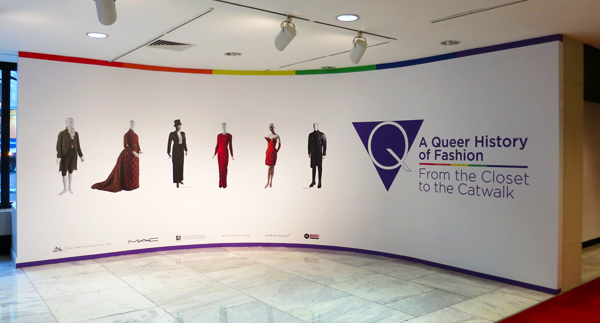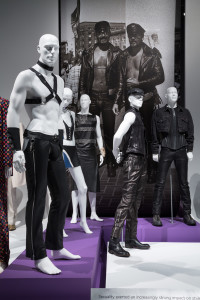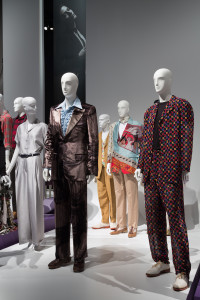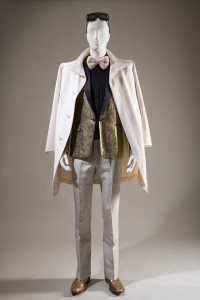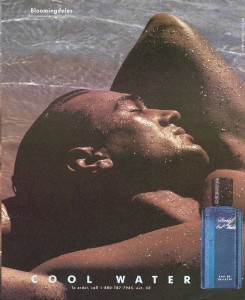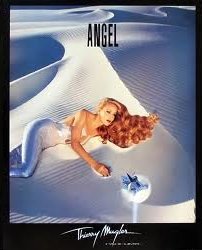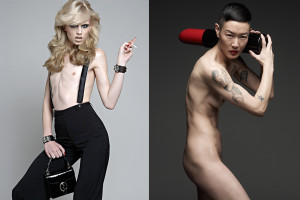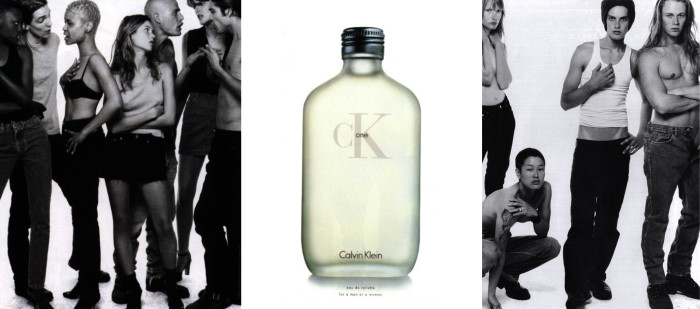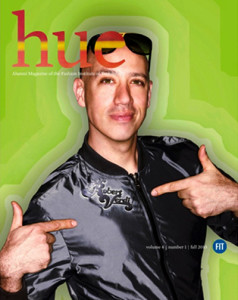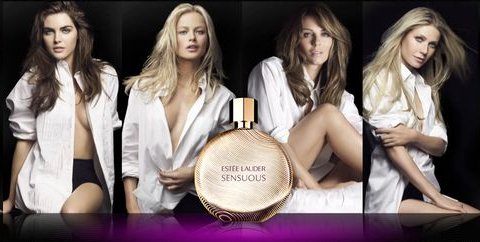A Queer History of Fashion:From The Closet to The Catwalk Exhibit at FIT. Photo Courtesy of FIT
Douglas Bender of Charenton Macerations and CaFleureBon Contributor introduced our readers to A Queer History of Fashion: From the Closet to the Catwalk, on view at The Museum at FIT now through January 4th, 2014 on 12/12/13. Co-Curators Valerie Steele and Fred Dennis, as well as style icon Robert Verdi walked the show with Douglas adding additional insights to the displays of fashion at the exhibit. Part 1 examined proto LGTBQ fashion and fragrances of the late 19th century through the Pre War era dubbed Pushing Boundaries: Mollies, Dandies & Les Garçonnes. Part Two explored Post-War Gender stereotypes, The Stonewall Riots and the In your Face Boldness of the early 1980s. We conclude the Series in Part 3; Queer fashion is out of the closet and onto the Catwalk -Michelyn Camen, Editor in Chief
Becoming Queer: Diversity & Fragmentation (1980s to Today)
Leather Installation View. Photo courtesy The Museum at FIT
Being on the outside of a society’s (heterosexual) norms can make it easier to see the artificiality of those norms. As Robert Verdi describes: Ascription of gender to inanimate objects is one of those things that has forever been a curious idea for me, because I don’t do it. Even though in our society we do ascribe “pink is for girls, blue is for boys, flowers for girls, stripes for boys”… I wear florals. I don’t care. I wear pink. I’ve always been that person that has let the ascription of gender fall away from, and disconnect, from the object". The exhibition shows over and over again how members of LGBTQ communities have picked up a piece of fashion and played with it in a way that exposes the artificiality of the idea that it only be used in this way or that, the absurdity of the notion that dresses are only for women or that suits are only for men.
At the end of the 20th century, there is an explosion of this kind of creativity in fashion, with queer style following diverse paths, drawing influence from various subcultural movements. For example, the exhibition dedicates an area to the influence of the leather scene on fashion. Claude Montana and Azzedine Alaia pioneered the use of leather in fashion. Versace later drew from BDSM subcultures for his 1992 bondage collection, taking subcultural references from the leather scene and injecting them into high fashion style. Over time, the styles associated with these sexual subcultures have become part of mainstream fashion’s vocabulary.
Neoprene and spandex, Spring/Summer 1996, France, lent by the Maison Jean Paul Gaultier. Photo courtesy The Museum at FIT
This section of the exhibition also looks at how designers like Gaultier and Mugler mash up gender signification in new ways. Gaultier’s pink sailor suit is one example of what Steele notes as being, “unafraid of playing fast and loose with sex and gender stereotypes.” That fearlessness also included, “promoting underwear as outerwear, [and] skirts for men.” Verdi discusses Gaultier’s skill in recontextualizing traditionally gendered pieces: "It’s an interesting idea, but take the garment and its intended function away, and it is an inanimate object that then we ascribe gender to. So, Gaultier has disarmed the object, it’s like disarming the bomb. When the object is just an object to be used as personal expression, it doesn’t have gender. People give it gender. If gender specificity was based on genitalia, you couldn’t apply that idea to objects. You couldn’t say that chair is a girl chair, because it doesn’t have a vagina. It’s not a female or male thing. We impose those ideas on objects".
Jean Paul Gaultier Fragrances
It is an exciting fashion moment, yet one that disappoints when translated into fragrance. The deft hand for “playing fast and loose with sex and gender stereotypes” is not as boldly applied to Gaultier’s fragrances. Jean Paul Gaultier (1993) is a soft, powdery floral and Le Mâle (1995) is a spicy, sheer, lavender-based fougère. Even Gaultier’s attempt at a unisex fragrance, Gaultier2 (2005) smells eerily similar to the original women’s fragrance. For all the originality in the Gaultier fashion experience, clever packaging barely masks the lack of any queer olfactive innovation.
Modern Suiting Installation View. Photo courtesy The Museum at FIT
The final looks on display in this section of the exhibition examine modern suiting. The suit has traditionally been an anchor of masculine style, and from the appropriations of the suit in the 1930s with Dietrich and lesbian elegance, to the vinyl tuxedo worn by Klaus Nomi, it has been a site ripe for transgression and gender play. The exhibition includes Verdi’s two “modern dandy” looks. The first is a tie-dyed velvet tuxedo from designer Tom Ford.
Tom Ford. Velvet, circa 2000, Italy, lent by Robert Verdi. Photo courtesy The Museum at FIT
As Robert explains: "One of the pieces [co-curators Valerie Steele and Fred Dennis] chose from my clothing was a velvet tie-dyed Tom Ford suit that he did for Gucci in the 90s… [T]here’s a tension between the silhouette and what they actually use to fabricate the garment. In this case, when you hear ‘tuxedo’ that word conjures up any number of things for people, but really the kind of penguin-like apparel that men have worn since the turn of the century. But in this case, this tuxedo happens to be tie-dyed velvet. So that tug of war therein between the actual tie-dye silk velvet – which is outrageous – is constructed in a very traditional silhouette. That’s where the nuance comes in. At the moment it was created, it was a very avant-garde idea: very forward thinking and completely decadent. I just fell in love with it and bought it in two colors".
The second look on display showcases Robert’s styling skill, mixing and matching pieces from a series of designers:
Tom Ford, overcoat, circa 1995, USA / Dsquared2, tuxedo jacket, Fall 2007, Italy / Gucci, trousers, circa 1995, Italy / Paul Smith, boots, England / Marc Jacobs, sunglasses, 2000s, USA.
Lent by Robert Verdi. Photo courtesy The Museum at FIT
Verdi continues, "The other look is a white coat from Gucci that was designed by Tom Ford in the 90s, and it’s over a DSquared2 gold lamé jacket with black satin lapels that’s from maybe 4 years ago… and with a fur bow tie that I had made and a pair of Gucci pants that were also from the Tom Ford era and Paul Smith gold boots from maybe 10 years ago. It was worn as shown… It’s interesting that I took all these pieces and I put them together and expressed myself using all these things these designers created. I think that’s what was interesting about the way they were going about putting the exhibition together. They wanted to see the individual queer voices come through. It’s like a Monet. From afar, you see the entire image, but when you look closely, you just see the stippling, the speckle of the color… I’m just one of those little color blips. And that’s where the viewpoint of Fred and Valerie was kind of interesting. They wanted the individual voices to be there, but they also wanted to show how those individual voices come together to create a collective viewpoint. The in-your-face boldness of these later suiting looks stand in stark contrast to the more nuanced styles of the 1950s suits of Cecil Beaton and Bunny Roger".
One of the first ads for Davidoff Cool Water featured model Joe Gogol
Despite the introduction of two new styles of fragrance in the 90s — marine and gourmand — the fragrance world has only begun to play with its own sex and gender rules in the meekest of ways. After decades of fougères, chypres and woods, masculine fragrance made a new departure during the late 80s with marines — a new freshness popularized by the success of Davidoff’s Cool Water (1988), a fragrance instantly recognizable by its overdose of dihydromycenol. Though first introduced in men’s fragrances, marine notes have since crossed over into feminine fragrances, yet generally only when paired with more traditional floral notes, as in Issey Miyake’s L’Eau d’Issey (1991).
First Celebrity featured in Mugler's Angel ad was Jerry Hall in 1993
For women, Mugler’s Angel (1992) gave birth to a new gourmand trend. After its success, a men’s version, A*Men (1996), was launched — structurally similar to Angel, but at a lower concentration and wrapped in cedar notes. While these new styles have crossed gender lines, they have tended to do so only in the context of traditionally gendered fragrance structures.
(left) Model Andrej Pejic, originally printed in SCHON (Issue 14), Photograph by Christos Karantzolas. (right) Model Jenny Shimizu, Helmut Red campaign. Photograph by Mark Seliger. Photos courtesy The Museum at FIT
Androgyny
In contrast to the transgressing and mashing up of different gender signifiers, a parallel movement moved away from strong masculine or feminine styles into a look that was more neutral. For example, the exhibition looks at 1990s androgyny with CK One cover girl Jenny Shimuzu, in concert with more modern examples of gender bending models like Stella Tennant and Andrej Pejic. As Verdi notes, “I think that androgyny is interesting because it’s kind of trying to keep the car in neutral without rolling and I think it’s trying to like remove the ascription of gender from things and making things neutral, and I appreciate that.”
In fragrance, androgyny is synonymous with unisexuality, an attempt to compose a scent deemed acceptable by both men and women because it reads as neither. Dior’s Eau Sauvage (1966), a fresh chypre though marketed to men, was adopted by both sexes and is often referred to as the first unisex fragrance. However, CK One (1994) remains the archetypical example of a unisex fragrance, a fresh citrus with a touch of floralcy; no fragrance marketed as unisex has ever matched its success.
Fall 2010 Hue Magazine Cover featuring Robert Verdi
Conclusion
In celebrating the contributions of LGBTQ designers to fashion, the exhibition highlights the fearlessness of designers and the communities from which they drew inspiration. They have used of fashion to push against the limits and boundaries of society’s accepted norms, norms of what it is to be a man and to be a woman in particular. In the middle of the last century, fragrance, perhaps partly a product of its unholy alliance with fashion, became caught up in these games. Fragrance became yet another product that helped a man be more masculine and a woman more feminine. It established yet another set of rules of what was appropriate for a man and for a woman. Fashion has spent decades playing with its own gender rules, cultivating a rebellious spirit powered by politics and pleasure that has driven creativity and innovation in the industry.
Gwyneth Paltrow, Elizabeth Hurley, Hilary Rhoda and Carolyn Murphy represented Estee Lauder's Sensous Perfume
The fragrance world, in contrast, has too often remained content to churn out the same fragrant stereotypes, often accompanied by increasingly anachronistic marketing campaigns. When fragrance has experimented with sex and gender norms, it has often been flaccid mimicry of fashion trends. There has been very little transgression of fragrance structures on their own terms. Demeter’s realist and hyper-real olfaction in the 1990s do transgress traditions of what a fragrance is. Yet, they didn’t engage with gendered fragrance structures in a sustained way. There are moments when notes are borrowed across gender lines, such as the wood note a la Estée Lauder’s Sensuous (2008). However, it is so overwhelmed with strong floral notes that it robs the nose of the bold juxtaposition possible with the blending of strong masculine and feminine notes. If you look for sex and gender transgression with fragrance structure, if you look for queer fragrance structures, they remain exceptionally rare. Fashion has drawn inspiration and creative vivaciousness through these struggles with fashion’s own gender norms, yet fragrance’s perfumers, many LGBTQ themselves, and some still in the closet, refuse this influence and spirit. Fragrance has yet to boldly embrace the transgressive play with sex and gender signifiers that have marked the history of queer fashion. There are rattles and rustlings of moments when fragrance breaks the rules, yet there is a queer revolution in fragrance that, shockingly as we grind our way into the 21st century, has still yet to come.
– Douglas Bender, Contributor and Founder of Charenton Macerations
Douglas Bender is the founder of Charenton Macerations, which endeavors to create fragrances that make a statement. The brand’s first fragrance, Christopher Street, in collaboration with Ralf Schwieger tells the stories of this iconic part of New York’s West Village, unencumbered by any allegiance to established gendered fragrance structures.
We would like to know your views and opinions. Are the influencers and marketers of Fragrance still in the closet? Who would you like to see in a mainstream ad campaign for men or for women? Do you wear mainstream/designer fragrances that are not marketed to your gender? Which Niche Houses promotes free expression and break the norms?
Thank you Douglas for these articles and please leave a comment…we want to hear from you and CaFleureBon and Douglas will continue exploring gender and fragrance in 2014.

